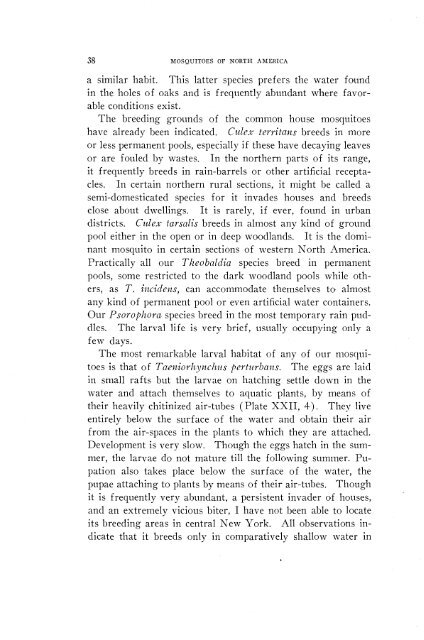a handbook of the mosquitoes of north america - Systematic Catalog ...
a handbook of the mosquitoes of north america - Systematic Catalog ...
a handbook of the mosquitoes of north america - Systematic Catalog ...
Create successful ePaper yourself
Turn your PDF publications into a flip-book with our unique Google optimized e-Paper software.
38 MOSQUITOES OF NORTH AMERICA<br />
a similar habit. This latter species prefers <strong>the</strong> water found<br />
in <strong>the</strong> holes <strong>of</strong> oaks and is frequently abundant where favor-<br />
able conditions exist.<br />
The breeding grounds <strong>of</strong> <strong>the</strong> common house <strong>mosquitoes</strong><br />
have already been indicated. CUZEX territam breeds in more<br />
or less permanent pools, especially if <strong>the</strong>se have decaying leaves<br />
or are fouled by wastes. In <strong>the</strong> nor<strong>the</strong>rn parts <strong>of</strong> its range,<br />
it frequently breeds in rain-barrels or o<strong>the</strong>r artificial recepta-<br />
cles. In certain nor<strong>the</strong>rn rural sections, it might be called a<br />
semi-domesticated s,pecies for it invades houses and breeds<br />
close about dwellings. It is rarely, if ever, found in urban<br />
districts. Czilex tarsnlis breeds in almost any kind <strong>of</strong> ground<br />
pool ei<strong>the</strong>r in <strong>the</strong> open or in deep woodlands. It is <strong>the</strong> domi-<br />
nant mosquito in certain sections <strong>of</strong> western North America.<br />
Practically all our Theobaldia species breed in permanent<br />
pools, some restricted to <strong>the</strong> dark woodland pools while oth-<br />
ers, as T. imidem, can accommodate <strong>the</strong>mselves to almost<br />
any kind <strong>of</strong> permanent pool or even artificial water containers.<br />
Our Psoroplzora species breed in <strong>the</strong> most temporary rain pud-<br />
dles. The larval life is very brief, usually occupying only a<br />
few days.<br />
The most remarkable larval habitat <strong>of</strong> any <strong>of</strong> our mosclui-<br />
toes is that <strong>of</strong> Taezziorlz31~zch,zks perturbam. The eggs are laid<br />
in small rafts but <strong>the</strong> larvae on hatching settle down in <strong>the</strong><br />
water and attach <strong>the</strong>mselves to aquatic plants, by means <strong>of</strong><br />
<strong>the</strong>ir heavily chitinized air-tubes (Plate XXII, 4). They live<br />
entirely below <strong>the</strong> surface <strong>of</strong> <strong>the</strong> water and obtain <strong>the</strong>ir air<br />
from <strong>the</strong> air-spaces in <strong>the</strong> plants to which <strong>the</strong>y are attached.<br />
Development is very slow. Though <strong>the</strong> eggs hatch in <strong>the</strong> sum-<br />
mer, <strong>the</strong> larvae do not mature till <strong>the</strong> following summer. Pu-<br />
pation also takes place below <strong>the</strong> surface <strong>of</strong> <strong>the</strong> water, <strong>the</strong><br />
pupae attaching to plants by means <strong>of</strong> <strong>the</strong>ir air-tubes. Though<br />
it is frequently very abundant, a persistent invader <strong>of</strong> houses,<br />
and an extremely vicious biter, I have not been able to locate<br />
its breeding areas in central New York. All observations in-<br />
dicate that it breeds only in comparatively shallow water in

















